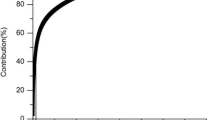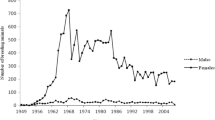Abstract
We evaluated the population genetic structure of the Holstein breed in Brazil through pedigree analysis with the aim of supporting genetic management of extant herds. We used data from genealogical records of 204,511 animals in farms from south and southeast Brazil. Pedigree records between 1943 and 2005 were divided into seven periods of 8 years to estimate the effective population size (N e ). N e varied during the study periods, ranging from 0.19 to 3016.25. There was an increase in the percentage of inbred animals over time, from 0.18 to 5.0 %. However, this figure may be an underestimate due to the low completeness of pedigree, primarily related to paternal pedigree. The effective number of founders (fe) was 473 animals and ancestors (fa) was 471. The genetic contribution of 260 ancestors (founders or not) accounted for 50 % of the genetic variability in the population. The average relatedness coefficient (AR) and inbreeding coefficient indicate that the Holstein breed in Brazil is being effectively managed, despite a moderate founder effect and the low number of animals that are responsible for the population variance.

Similar content being viewed by others
References
Almeida, D.L., 2000. O uso da inseminação artificial em bovinos no Brasil. Análise da cadeia produtiva animal. 4° Congresso de agribusiness.
ASBIA – Associação Brasileira de Inseminação Artificial, 1995. Relatório Anual. Uberaba, MG: 18 p
ASBIA – Associação Brasileira de Inseminação Artificial, 2007. Relatório estatístico de produção, importação e comercialização de sêmen. http://www.asbia.org.br/novo/upload/mercado/relatorio2007.pdf. Accessed 18 June 2014
ASBIA – Associação Brasileira de Inseminação Artificial, 2013. Relatório estatístico de produção, importação e comercialização de sêmen. http://www.asbia.org.br/novo/upload/mercado/index2013.pdf. Accessed 2 July 2014
ASBIA – Associação Brasileira de Inseminação Artificial, 2014. Relatório estatístico de produção, importação e comercialização de sêmen. http://www.asbia.org.br/novo/upload/mercado/index2014.pdf. Accessed 22 April 2014
Belonsky, G.M. and Kennedy, B.W., 1988. Selection on individual phenotype and best linear unbiased predictor of breeding values in a closed swine herd, Journal of Animal Science, 66:5, 1124–31
Canaza-Cayo, A.W., Lopes, P.S., Silva, M.V.G.B., Cobuci, J.A., Torres, R.A., Martins, M.F. and Arbex, W.A., 2014. Estrutura populacional da raça Girolando. Ciência Rural, 44:11, 2072–2077
Costa, C.N., Teixeira, N.M., Freitas, A.F., Cobuci, J.A. and Haguihara, K., 2004. Trends in milk recording of the Holstein breed in Brazil. Proceeding of the 34th Biennal Session of ICAR, Sousse Tunisia, EAAP, publication 113
Echeverri, J., Saldamando, C.I. and López-Herrera, A., 2015. Genetic structure analysis of a Holstein cow population in Colombia. Revista Colombiana de Ciencias Pecuaria, 28, 54–63
Falleiro, V.B., Malhado, C.H.M., Malhado, A.C.M., Carneiro, P.L.S., Carrillo, J.A., Jiuzhou, S., 2014. Population Structure and Genetic Variability of Angus and Nellore Herds. Journal of Agricultural Science, 6, 276
Frankham, R., 1995. Conservation genetics. Annual Review of Genetics, 29, 305–327
Goyache, F., Fernandez, I., Espinosa, M.A., Payeras, L., Pérez-Pardal, Gutiérrez J.P., Royo, L.J. and Álvarez, I., 2010. Análisis demográfico y genético de la raza ovina Mallorquina. Información Técnica Económica Agraria, 106, 3–14
Gutierrez, J.P. and Goyache, F., 2005. A note on ENDOG: a computer program for analysis pedigree information. Journal of Animal Breeding and Genetics, 122, 172–176
Gutierrez, J.P., Altarriba, J., Dıaz, C., Quintanilla, R., Canon, J. and Piedrafita, J., 2003. Genetic analysis of eight Spanish beef cattle breeds. Genetics Selection Evolution, 35, 1–21
Gutierrez, J.P., Cervantes, I., Molina, A., Valera, M. and Goyache, F., 2008. Individual increase in inbreeding allows estimating effective sizes from pedigrees. Genetics Selection Evolution, 40, 359–378
Hill, W.G., 1979. A note on effective population size with overlapping generations. Genetics, 92, 317–322
Lacy, R.C., 1989. Analysis of founder representation in pedigrees: founder equivalents and founder genome equivalents. Zoo Biology, 8, 111–123
Maiwashe, A., Nephawe, K.A., van der Westhuizen, R.R., Mostert, B.E. and Theron, H.E., 2006. Rate of inbreeding and effective population size in four major South African dairy cattle breeds. South African Journal of Animal Science, 36, 50 – 57
Malhado, C.H.M., Malhado, A.C.M., Carneiro, P.L.S., Ramos, A.A., Ambrosini, D.P. and Pala, A., 2012. Population structure and genetic variability in the Murrah dairy breed of water buffalo in Brazil accessed via pedigree analysis. Tropical Animal Health and Production, 44, 1891–1897
Malhado, C.H.M., Malhado, A.C.M., Carneiro, P.L.S., Ramos, A.A., Carrilo, J.A. and Pala, A., 2013. Inbreeding depression on production and reproduction traits of buffaloes from Brazil. Animal Science Journal, 84, 289–295
MAPA – Ministério da Agricultura, Pecuária e Abastecimento, 2012. Brasil Projeções do Agronegócio 2011/2012 a 2021/2022. Resumo Executivo. http://www.agricultura.gov.br/arq_editor/file/Ministerio/gestao/projecao/Projecoes%20do%20Agronegocio%20Brasil%202011-20012%20a%202021-2022%20-%20Sintese(2).pdf. Accessed 15 May 2014
Meuwissen, The. and Luo, Z., 1992. Computing inbreeding coefficients in large populations. Genetic Selection Evolution, 24, 305–313
Meuwissen, The., Woolliams, J., 1994. Effective sizes of livestock populations to prevent a decline in fitness. Theor. Journal of Applied Genetics, 89, 1019–1026
Muasya, T.K., Peters, K.J. and Kahi, A.K., 2013. Breeding structure and genetic variability of the Holstein Friesian dairy cattle population in Kenya. Animal Genetic Resources/Ressources génétiques animales/Recursos genéticos animales, 52, 127–137
Pavlik, I., Kadlecik, O., Hazuchova, E. and Kasarda, R., 2012. Pedigree Analysis of Holstein Bulls in Slovakia. Scientific Papers: Animal Science and Biotechnologies, 45, 230–234
Sørensen, A.C., Sørensen, M.K. and Berg, P., 2005. Inbreeding in Danish dairy cattle populations. Journal of Dairy Science, 88, 1865–1872
Thompson, J.R., Everett, R.W. and Hammerschmidt, N.L., 2000. Effects of inbreeding on production and survival in Holstein. Journal of Dairy Science, 83, 1856–1864
Weigel, K.A., 2001. Controlling inbreeding in modern breeding programs. Journal of Dairy Science, 84, 177–184
Weller, J.I. and Ezra, E., 2005. Analysis of inbreeding in the Israeli Holstein dairy cattle population. Proceedings of the 2005 Interbull meeting, 33, 85–87
Acknowledgments
The authors would like to acknowledge the Brazilian Association of Holstein Breeders (ABCBRH) for the granting of the data and to the technical experts of the Genealogical Registry Service (SRG) for the data collection of this information that made possible the development of this study.
Author information
Authors and Affiliations
Corresponding author
Ethics declarations
Statement of animal rights
The manuscript does not contain clinical studies or patient data. Animal welfare and use committee approval was not necessary for this study because data were obtained from preexisting databases.
Conflict of interest
The authors declare that they have no competing interests.
Rights and permissions
About this article
Cite this article
Magalhães Araújo da Silva, M.H., Malhado, C.H.M., Costa, J.L. et al. Population genetic structure in the Holstein breed in Brazil. Trop Anim Health Prod 48, 331–336 (2016). https://doi.org/10.1007/s11250-015-0956-7
Received:
Accepted:
Published:
Issue Date:
DOI: https://doi.org/10.1007/s11250-015-0956-7




